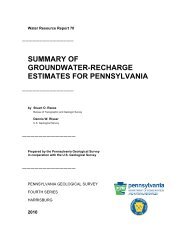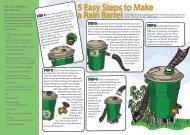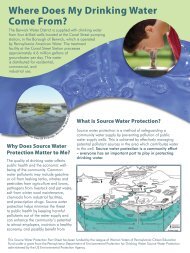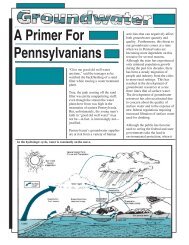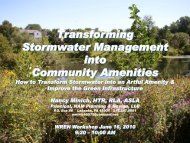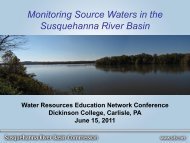NITROGEN POLLUTION: - Hubbard Brook Research Foundation
NITROGEN POLLUTION: - Hubbard Brook Research Foundation
NITROGEN POLLUTION: - Hubbard Brook Research Foundation
You also want an ePaper? Increase the reach of your titles
YUMPU automatically turns print PDFs into web optimized ePapers that Google loves.
Reactive nitrogen loading from wastewater<br />
treatment plants in the Northeast is linked to the<br />
high population density in the coastal zone. Densely<br />
populated urban centers along the coastal zone<br />
generate large amounts of reactive nitrogen in<br />
human waste that is then discharged through<br />
septic systems and wastewater treatment plants.<br />
Unfortunately, conventional septic systems are<br />
not designed to remove reactive nitrogen. Moreover,<br />
most wastewater treatment plants do not employ<br />
tertiary biological nitrogen removal (BNR)<br />
technologies and discharge high levels of reactive<br />
nitrogen to surface waters.<br />
The contribution of reactive nitrogen to coastal<br />
waters from atmospheric deposition includes<br />
nitrogen that is deposited directly to the estuary as<br />
well as nitrogen deposited on the watershed that<br />
ultimately is transported downstream to the estuary.<br />
Agricultural and urban runoff is also an<br />
important contributor to the loading of reactive<br />
nitrogen in some estuaries. As compared to<br />
undisturbed forests, agricultural, suburban and urban<br />
lands produce nitrogen-rich runoff (see Figure 15).<br />
This reactive nitrogen originates from many sources<br />
including lawn and garden fertilizer, crop fertilizer,<br />
animal manure, urban runoff and sewer overflows.<br />
Coastal ecosystems are naturally very rich in plant and animal life. However,<br />
since the richness (or productivity) of saltwater ecosystems is naturally limited by<br />
the availability of reactive nitrogen, excess nitrogen can lead to a condition of<br />
over-enrichment known as eutrophication. According to a study by the National<br />
Oceanic and Atmospheric Administration, of 23 estuaries examined in the Northeast,<br />
61 percent were classified as moderately to<br />
severely degraded by nutrient over-enrichment<br />
(Bricker et al. 1999).<br />
The over-enrichment of estuaries promotes<br />
the excessive growth of algae. The increased<br />
algal growth can shade-out seagrass beds<br />
and other submerged aquatic vegetation that<br />
provide critical habitat for fish and other marine<br />
organisms. Furthermore, when the algae die<br />
and decompose, oxygen in the bottom water<br />
is consumed. Low oxygen conditions, known<br />
as hypoxia, can cause fish and shellfish<br />
suffocation. Hypoxia has occurred across large<br />
areas in Long Island Sound each year for the<br />
past decade (see Figure 16).<br />
Waquoit Bay in Massachusetts is an<br />
example of an estuary where the effects of<br />
elevated nitrogen have been documented<br />
over several decades. Suburban residences<br />
PAGE 16<br />
80<br />
70<br />
60<br />
50<br />
40<br />
30<br />
20<br />
10<br />
0<br />
1991 1992 1993 1994 1995 1996 1997 1998 1999 2000<br />
on permeable soils dominate this watershed where wastewater and atmospheric<br />
deposition contribute large amounts of reactive nitrogen to the estuary. Long-term<br />
research from this site has allowed scientists to quantify the relationship between<br />
the increase in total reactive nitrogen loading to the estuary and the decreased<br />
eelgrass habitat (see Figure 17).<br />
Stream N (mg N/L)<br />
LAND USE AND<br />
<strong>NITROGEN</strong> IN RUNOFF<br />
Duration<br />
Area<br />
ROW CROP<br />
URBAN<br />
SUBURBAN<br />
FORESTED<br />
FIGURE 15: k<br />
Nitrogen concentrations<br />
in streams draining<br />
different land types.<br />
1200<br />
1000<br />
800<br />
600<br />
400<br />
200<br />
FIGURE 16: k<br />
The occurrence of low<br />
oxygen events in Long<br />
Island Sound. Data<br />
source: Connecticut<br />
Department of<br />
Environmental<br />
Protection.<br />
0



